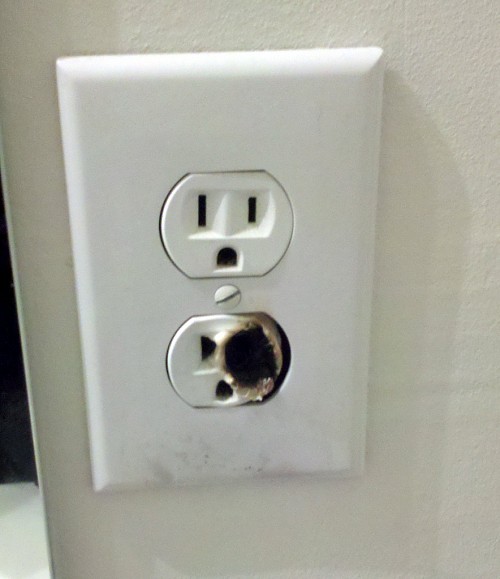When Does an Electrical Outlet Need to be Replaced?
An electrical outlet in a busy part of the house like your bathroom, kitchen, or home workroom has a difficult life. The outlet (also known as a receptacle) is subject to a great deal of wear and tear. Once an outlet has been damaged or is simply past its prime, it is not just an inconvenience, it can be downright dangerous. Avoid the possibility of electric shocks or burns by learning the signs that indicate you need to replace your electrical outlet.
Signs It's Time to Replace an Electrical Outlet
The faceplate is broken, chipped, or cracked, permitting dangerous electrical arcing when you try to insert a plug.
The slots have loosened so that they will allow the weight of the cord to pull the plug out of the receptacle, rather than remaining firmly -- and safely -- in place.
The plastic of your outlet cover feels warm to the touch, is darkened or charred looking, or gives off an unpleasant burnt smell. Deterioration of internal contacts or wire terminals can cause overheating, with eventual melting and the possibility of sparking or -- worst of all -- an electrical fire. Treat this as an emergency warning! Flip the circuit breaker which controls that particular outlet to the "Off" position and contact a reliable electrician immediately.
The outlet produces electric shocks. In this case, the problem could be due to one of three causes: an appliance you are presently using, the outlet itself, or the wiring. Unplug the appliance to investigate whether that might be the trouble source. Otherwise, have an electrician examine the outlet and the wiring for faults.
The outlet has gone dead. First, see whether your other outlets are functioning. Then look for a tripped breaker or GFCI device and reset as necessary. If this doesn't solve your problem, check the outlet with an outlet tester. Plug in a small appliance (one which works fine in other outlets) to be sure that the problem is in the receptacle itself.
Another cause of outlet failure is exposure to moisture. That is why GFCI (ground fault circuit interrupter) outlets are increasingly required in areas of the home where water is used, such as kitchens, bathrooms, laundries, wet bars, outdoor spas, and the like. If your outlet has become damp, flip the corresponding breaker and consult an electrician.
You have an ungrounded outlet -- the type with 2 slots. (The safer grounded type has 2 slots and a 3rd hole resembling a mouth.) To protect yourself and your family against shocks, do not simply replace your ungrounded receptacle with a grounded type. Instead, install a GFCI outlet, or hire a professional electrician to upgrade your outlets.
Proper Care of Electrical Outlets
Take good care to avoid damaging your electrical outlets and prevent injury to human beings.
- Insert plugs into the outlet gently to minimize wear.
- Switch off appliances, lamps, and other electrical devices before unplugging them.
- Pull on the plug, not the cord, to detach from the outlet. And never, ever pull on the cord at an angle. This prevents two types of damage -- to the cord itself and also to the receptacle.
- Avoid overloading an outlet with multi-way plugs, extension cords, or appliances with faulty wiring.
- If you live in an older home, built prior to 1975, check each outlet with an outlet tester to verify whether they are properly wired and safely grounded. Replace any electrical outlet that does not pass the test.
- Be aware that electrical receptacles in areas such as kitchens and baths will tend to need replacement more frequently, due to their continual exposure to steam, heat, and cleaning products.
Laura Firszt writes for networx.com.
Updated January 25, 2018.
Looking for a Pro? Call us (866) 441-6648

Electrical Average Costs
Electricians Experiences

Electrical Wiring For Our New Shed

I Wanted To Hire An Electrician To Wire Our New Hot Tub – The RIGHT Way




